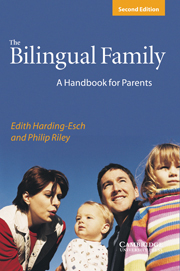Part II - Case studies: a number of bilingual families, and how they did it
Published online by Cambridge University Press: 29 March 2010
Summary
In this section, you will find eighteen case studies in which we have tried to paint the ‘linguistic family portraits’ of a variety of bilingual families. These studies are based on observation and extensive interviewing. In the preparation of the second edition, we have been able to contact some of the children whose parents had been interviewed nearly twenty years ago and we asked them for their thoughts about their bilingual experience. Quotes from them have been added at the end of the relevant case studies. We wish to express here our gratitude for their kind cooperation.
What we hope to do is to describe to present or future parents of bilingual children a representative selection of the arrangements that the families in question have found to be feasible and practical in their particular situations. By comparing the descriptions given here with your own circumstances, you will be able to take advantage of the accumulated experience which these studies contain and to make more informed decisions.
Do not be surprised, though, if you do not find a case study that corresponds exactly to your own situation. As we have tried to show, bilingualism is a complex phenomenon and the changes that can be rung on it seem infinite. None the less, we do believe that these cases do cover, at least in outline, the most common and successful forms of family bilingualism.
- Type
- Chapter
- Information
- The Bilingual FamilyA Handbook for Parents, pp. 93 - 134Publisher: Cambridge University PressPrint publication year: 2003



